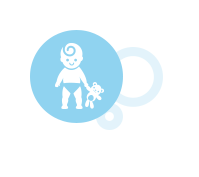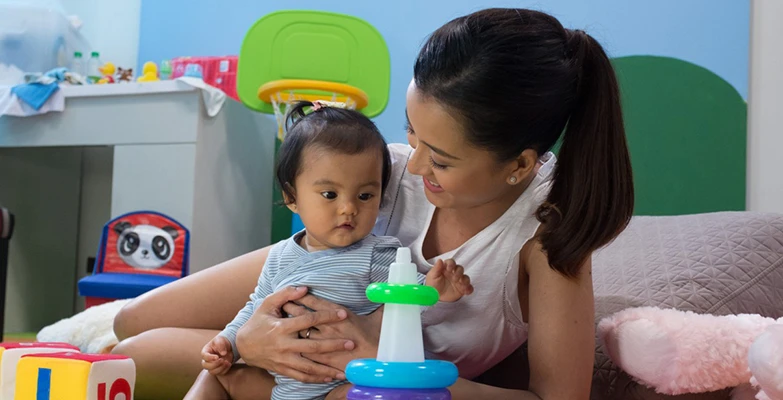Milestones of Development
Seeing your baby achieve her milestones can fill you with pride and joy. But more than just being signs of progress, developmental milestones are also good indicators of how safe and secure your baby really feels.
Your baby develops better when she feels safe and secure.
Each baby develops at their own pace. Your care, however, goes a long way in helping your child develop fully and happily.
On top of feeding your baby and providing for her physical needs, one of the best ways you can care for your child is to communicate and interact with her by responding to her nonverbal emotional cues.
The little coos, the curious eyes, the outstretched hands…all these are your baby’s way of communicating with you. When you’re able to respond with a loving look, a gentle touch, a playful whisper, you’re actually telling baby that she can trust you, which in turn builds her feelings of safety, security, and self-confidence.
Experts call this the Secure Attachment Bond, and it serves as the foundation for every aspect of baby’s development – from the social and emotional, to the physical and intellectual.
Milestones can be a sign of security.
Instead of seeing this list of milestones as a strict timeline, it’s better to view it as a guide that could help you understand your baby and her feelings of safety and security.
Since a Secure Attachment Bond can encourage development, the milestones your baby achieves can also tell us whether she feels as safe and secure as she should be in order to grow optimally.
By knowing what to watch out for at every stage, you can find out if you need to strengthen the communication and interaction between you and your baby.
Here are the developmental milestones to look for:

Between birth and 3 months
Toys, movement and bright colors catch her attention and make her react
She responds to sounds by turning towards them
She looks at people’s faces with interest
She smiles back at you

Between 3 and 6 months
She expresses joy when she interacts with you
She shares how she feels by making sounds like cooing, crying and babbling
She smiles a lot while she’s playing

Between 4 and 10 months
She makes a lot of sounds and facial expressions
She becomes more playful
Back-and-forth exchanges are now possible with her, whether through gestures (e.g. giving and taking) or through sounds and expressions

Between 10 and 18 months
She plays games like peek-a-boo with you
She can make monosyllabic sounds like “ma” and “da”
She uses gestures like pointing or waving to tell you what she needs
She responds to her name when called

Between 18 and 20 months
She can understand at least 10 words
She uses at least 4 consonants (e.g. b, d, m, p) when babbling
She uses words and motions to let you know what she wants
She likes simple pretend play, like feeding her doll
She recognizes the names of some people and some body parts

At 24 months
She can understand at least 50 words
She puts two words together when talking (e.g. “want play”)
She engages in more complex pretend play, such as feeding a doll then putting her to bed
She gives toys to others as a sign that she wants to play with them
She looks for people and objects that are not present when asked where they are

At 36 months
She can connect words and actions together (e.g. “hungry, want cookies”)
She likes playing with and talking to other kids
She talks about how she feels and what she likes, and has a basic grasp of time (e.g. past, future)
She gets better at answering “what,” “who,” “where,” and “when” questions
She pretends to be different characters by dressing up or using props
Think of missed milestones as an opportunity to strengthen your bond.
There is no such thing as a perfect parent who can be attentive to her child’s needs 24/7. So if your child misses a milestone or two, don’t fret. Every baby is unique and follows their own specific timeline. Also, your baby’s brain is still developing and changing, so even if the attachment bond is not so strong at times, you can still take steps to repair it.
You may reinforce the bond by focusing on connecting with your baby. Pay attention to her cues and use your gentle touch, loving gaze and comforting voice to ease her back into a place of safety and security.
Whenever you do this, you deepen your baby’s trust in you and your bond can come back stronger than ever.
However, if you’re worried about your baby consistently missing milestones, it’s best to consult with your pediatrician.
Earn your baby’s trust and watch her grow.
Milestones become even more meaningful when you look at them as signs that your baby trusts you. It’s this trust, this feeling of safety and security, that will give your baby the confidence she needs to connect with others and explore the world around her.
When you put in the time and effort to really communicate with your baby – not just to meet her needs but also to interact with her, be present for her and respond to her cues – you will be well rewarded with a child who is the best version of who she can be.
Moms around the world trust JOHNSON’S® to care for their babies
We are committed to working with moms, healthcare experts and scientists to ensure our products continue achieving the highest JOHNSON’S® baby standards.
Learn how we're making JOHNSON’S® products even better for your baby >
Toddler Bathing
Make brushing your toddler’s teeth a part of his bathing routine.

Baby Bath Seats
Baby bath seats have recently undergone changes to align with stricter safety standards — but they are still controversial. BabyCenter® shares what to look for if you purchase one.
